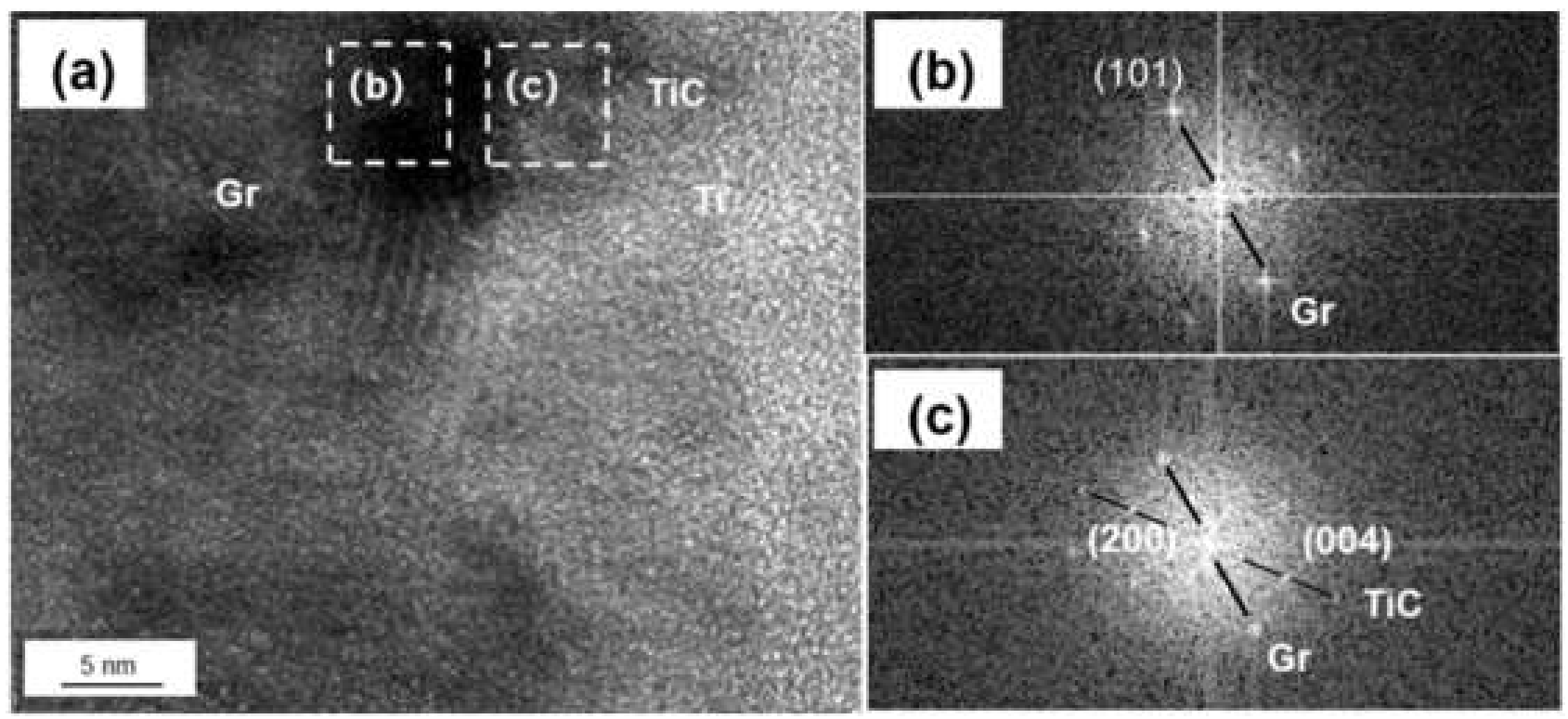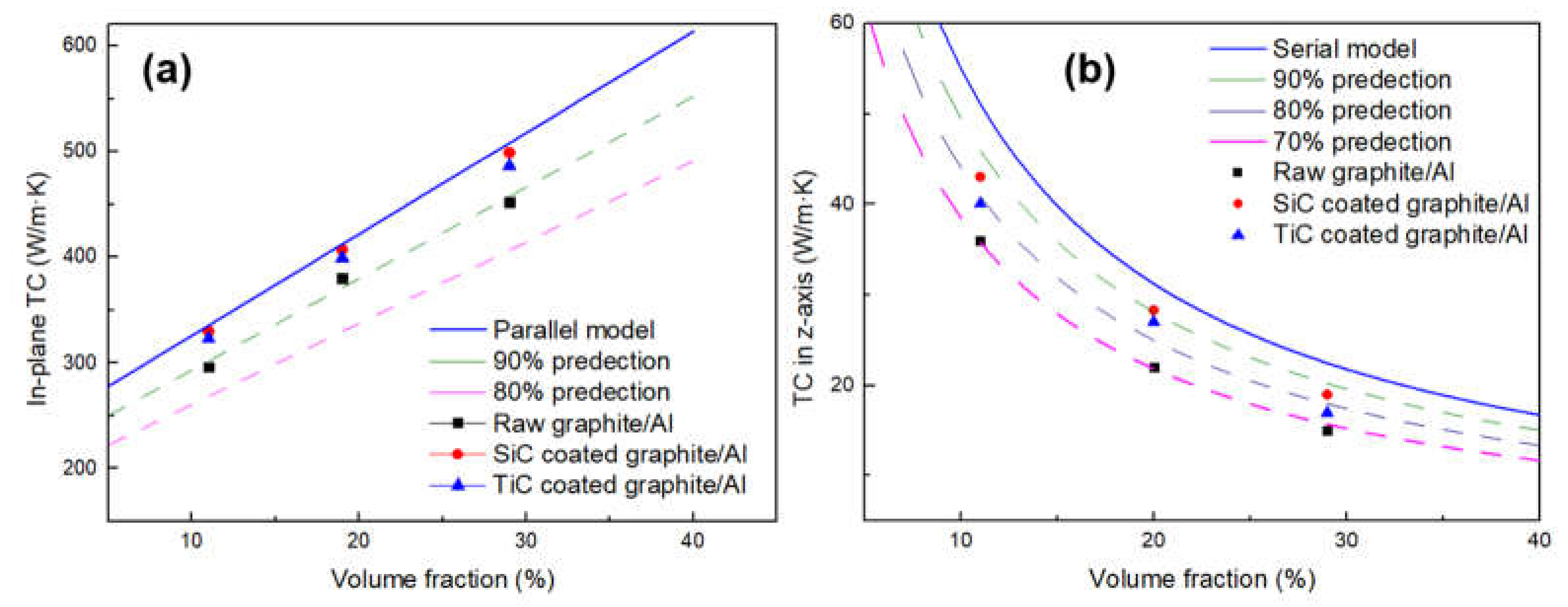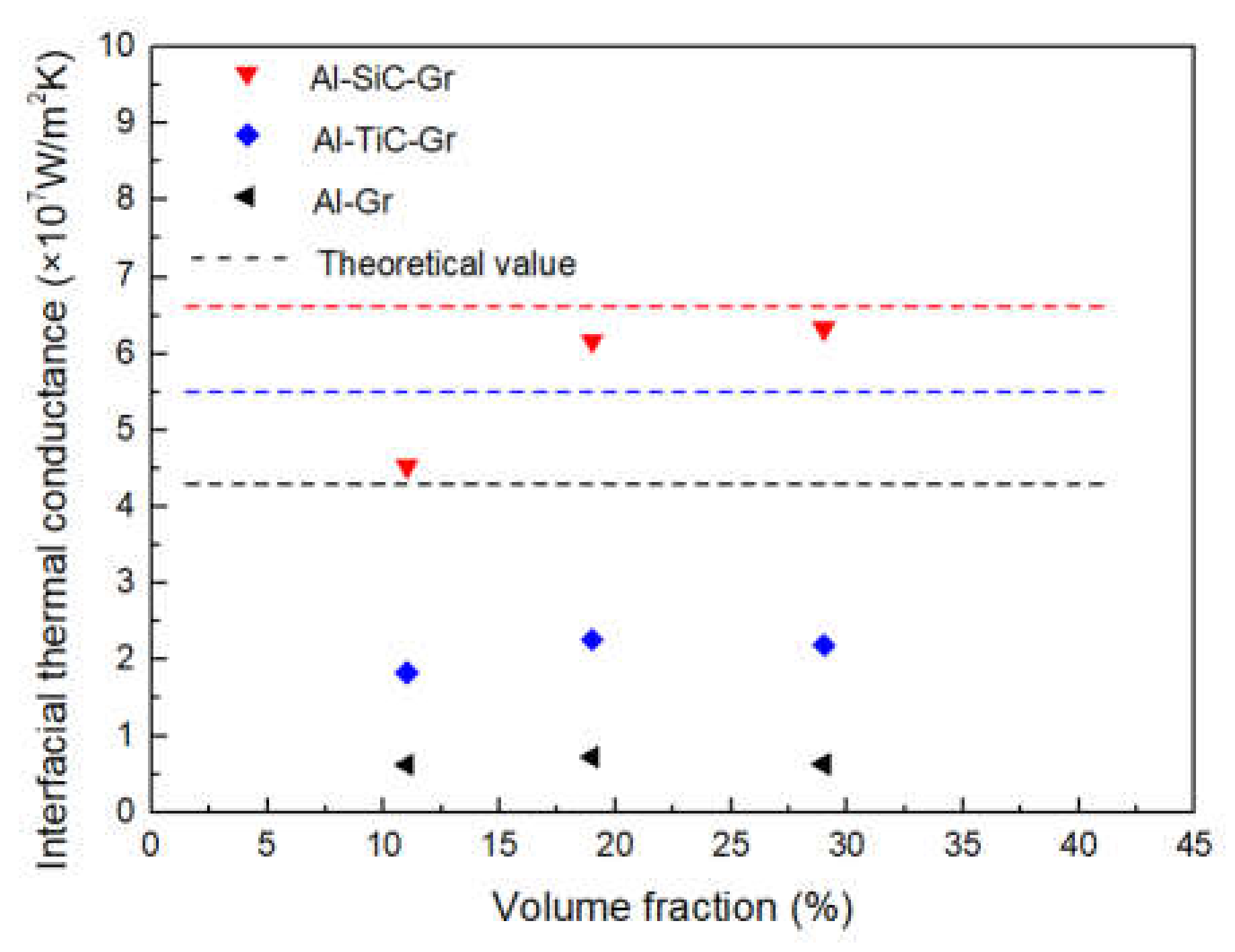Interfacial Structure of Carbide-Coated Graphite/Al Composites and Its Effect on Thermal Conductivity and Strength
Abstract
:1. Introduction
2. Materials and Methods
2.1. Raw Materials
2.2. Carbide Coating on the Graphite
2.3. Preparation of Graphite/Al Composites
2.4. Characterization
3. Results and Discussion
3.1. Microstructures Characterization of the Coated Graphite
3.2. Microstructure Characterization of Ti-Coated Graphite/Al Composites
3.3. Microstructure Characterization of Si-Coated Graphite/Al Composites
3.4. Thermal and Mechanical Properties
4. Conclusions
Author Contributions
Funding
Institutional Review Board Statement
Informed Consent Statement
Data Availability Statement
Conflicts of Interest
References
- Sidhu, S.S.; Kumar, S.; Batish, A. Metal matrix composites for thermal management: A review. Crit. Rev. Solid State Mater. Sci. 2016, 41, 132. [Google Scholar] [CrossRef]
- Shu, S.; Yang, H.; Tong, C.; Qiu, F. Fabrication of TiCx-TiB2/Al Composites for Application as a Heat Sink. Materials 2016, 9, 642. [Google Scholar] [CrossRef] [PubMed] [Green Version]
- Reyez-Araiza, J.L.; Pineda-Piñón, J.; López-Romero, J.M.; Gasca-Tirado, J.R.; Arroyo Contreras, M.; Jáuregui Correa, J.C.; Apátiga-Castro, L.M.; Rivera-Muñoz, E.M.; Velazquez-Castillo, R.R.; Pérez Bueno, J.d.J.; et al. Thermal Energy Storage by the Encapsulation of Phase Change Materials in Building Elements—A Review. Materials 2021, 14, 1420. [Google Scholar] [CrossRef]
- Mathias, J.D.; Geffroy, P.M.; Silvain, J.F. Architectural optimization for microelectronic packaging. Appl. Therm. Eng. 2009, 29, 2391–2395. [Google Scholar] [CrossRef] [Green Version]
- Rawal, S.P. Metal-matrix composites for space applications. JOM 2001, 53, 14–17. [Google Scholar] [CrossRef]
- Kim, Y.S.; Kim, J.K.; Jeon, E.S. Effect of the Compounding Conditions of Polyamide 6, Carbon Fiber, and Al2O3 on the Mechanical and Thermal Properties of the Composite Polymer. Materials 2019, 12, 3047. [Google Scholar] [CrossRef] [PubMed] [Green Version]
- Che, Z.; Li, J.; Wang, Q.; Wang, L.; Zhang, H.; Zhang, Y.; Wang, X.; Wang, J.; Kim, J.M. The formation of atomic-level interfacial layer and its effect on thermal conductivity of W-coated diamond particles reinforced Al matrix composites. Compos. Part A Appl. Sci. Manuf. 2018, 107, 164–170. [Google Scholar] [CrossRef]
- Athanasiou, M.; Samartzis, N.; Sygellou, L.; Dracopoulos, V.; Yannopoulos, S.N. High-quality laser-assisted biomass-based turbostratic graphene for high-performance supercapacitors. Carbon 2020, 172, 750–761. [Google Scholar] [CrossRef]
- Han, X.; Huang, Y.; Zhou, S.; Sun, X.; Peng, X.; Chen, X. Effects of graphene content on thermal and mechanical properties of chromium-coated graphite flakes/Si/Al composites. J. Mater. Sci. 2017, 29, 4179–4189. [Google Scholar] [CrossRef]
- Prieto, R.; Molina, J.M.; Narciso, J.; Louis, E. Thermal conductivity of graphite flakes—SiC particles/metal composites. Compos. Part A Appl. Sci. Manuf. 2011, 42, 1970–1977. [Google Scholar] [CrossRef]
- Zhou, C.; Ji, G.; Chen, Z.; Wang, M.; Addad, A.; Schryvers, D.; Wang, H. Fabrication, interface characterization and modeling of oriented graphite flakes/Si/Al composites for thermal management applications. Mater. Des. 2014, 63, 719–728. [Google Scholar] [CrossRef]
- Li, W.; Liu, Y.; Wu, G. Preparation of graphite flakes/Al with preferred orientation and high thermal conductivity by squeeze casting. Carbon 2015, 95, 545–551. [Google Scholar] [CrossRef]
- Zhou, S.; Chiang, S.; Xu, J.; Du, H.; Li, B.; Xu, C.; Kang, F. Modeling the in-plane thermal conductivity of a graphite/polymer composite sheet with a very high content of natural flake graphite. Carbon 2012, 50, 5052–5061. [Google Scholar] [CrossRef]
- Huang, Y.; Ouyang, Q.; Guo, Q.; Guo, X.; Zhang, G.; Zhang, D. Graphite film/aluminum laminate composites with ultrahigh thermal conductivity for thermal management applications. Mater. Des. 2016, 90, 508–515. [Google Scholar] [CrossRef]
- Huang, Y.; Su, Y.; Guo, X.; Guo, Q.; Ouyang, Q.; Zhang, G.; Zhang, D. Fabrication and thermal conductivity of copper coated graphite film/aluminum composites for effective thermal management. J. Alloy. Compd. 2017, 3, 233–239. [Google Scholar] [CrossRef]
- Wang, C.; Bai, H.; Xue, C.; Tong, X.; Zhu, Y.; Jiang, N. On the influence of carbide coating on the thermal conductivity and flexural strength of X (X = SiC, TiC) coated graphite/Al composites. RSC Adv. 2016, 6, 107483–107490. [Google Scholar] [CrossRef]
- Xue, C.; Bai, H.; Tao, P.; Wang, J.; Jiang, N.; Wang, S. Thermal conductivity and mechanical properties of flake graphite/Al composite with a SiC nano-layer on graphite surface. Mater. Des. 2016, 108, 250–258. [Google Scholar] [CrossRef]
- Agari, Y.; Uno, T. Estimation on thermal conductivities of filled polymers. J. Appl. Polym. Sci. 2010, 32, 5705–5712. [Google Scholar] [CrossRef]
- Hasselman, D.; Johnson, L. Effective Thermal Conductivity of Composites with Interfacial Thermal Barrier Resistance. J. Compos. Mater. 1987, 21, 508–515. [Google Scholar] [CrossRef]
- Swartz, E.T.; Pohl, R.O. Thermal boundary resistance. Rev. Mod. Phys. 1989, 61, 605–668. [Google Scholar] [CrossRef]
- Chu, K.; Jia, C.; Liang, X.; Chen, H.; Gao, W.; Guo, H. Modeling the thermal conductivity of diamond reinforced aluminium matrix composites with inhomogeneous interfacial conductance. Mater. Des. 2009, 30, 4311–4316. [Google Scholar] [CrossRef]
- Tan, Z.; Li, Z.; Xiong, D.; Fan, G.; Ji, G.; Zhang, D. A predictive model for interfacial thermal conductance in surface metallized diamond aluminum matrix composites. Mater. Des. 2014, 55, 257–262. [Google Scholar] [CrossRef]
- Hofmann, M.; Zywietz, A.; Karch, K.; Bechstedt, F. Lattice dynamics of SiC polytypes within the bond-charge model. Phys. Rev. B Condens. Matter. 1994, 50, 13401. [Google Scholar] [CrossRef] [PubMed]












| Parameter | 2θ (°) | FHWM | d002 (nm) | (%) |
|---|---|---|---|---|
| Value | 26.549 | 0.225 | 0.3357 | 96.51 |
| Material | TC (W/m·K) | Specific Heat (J/kg·K) | Phonon Velocity (m/s) | Density (kg/m3) | Reference |
|---|---|---|---|---|---|
| Graphite | 1189 | 710 | 14,800 | 2100 | [11] |
| Aluminum | 230 | 904 | 12,164 | 2700 | [21] |
| TiC | 17 | 568 | 6777 | 4930 | [22] |
| SiC | 483 | 670 | 7925 | 3220 | [23] |
| Surface Condition of Graphite | Volume Fraction (%) | Tensile Strength (MPa) | Yield Strength (MPa) | Elongation Rate (%) |
|---|---|---|---|---|
| Raw graphite | 11.1 | 106 | 50 | 22.5 |
| 19.8 | 68 | 29 | 10.3 | |
| 28.7 | 32 | - | 4.3 | |
| TiC-coated | 11.1 | 114 | 58 | 25.5 |
| 19.8 | 82 | 43 | 11.4 | |
| 28.7 | 44 | 23 | 6.7 | |
| SiC-coated | 11.1 | 112 | 58 | 25.5 |
| 19.8 | 74 | 35 | 10.4 | |
| 28.7 | 39 | 19 | 5.6 |
Publisher’s Note: MDPI stays neutral with regard to jurisdictional claims in published maps and institutional affiliations. |
© 2021 by the authors. Licensee MDPI, Basel, Switzerland. This article is an open access article distributed under the terms and conditions of the Creative Commons Attribution (CC BY) license (https://creativecommons.org/licenses/by/4.0/).
Share and Cite
Jia, H.; Fan, J.; Liu, Y.; Zhao, Y.; Nie, J.; Wei, S. Interfacial Structure of Carbide-Coated Graphite/Al Composites and Its Effect on Thermal Conductivity and Strength. Materials 2021, 14, 1721. https://doi.org/10.3390/ma14071721
Jia H, Fan J, Liu Y, Zhao Y, Nie J, Wei S. Interfacial Structure of Carbide-Coated Graphite/Al Composites and Its Effect on Thermal Conductivity and Strength. Materials. 2021; 14(7):1721. https://doi.org/10.3390/ma14071721
Chicago/Turabian StyleJia, Hao, Jianzhong Fan, Yanqiang Liu, Yuehong Zhao, Junhui Nie, and Shaohua Wei. 2021. "Interfacial Structure of Carbide-Coated Graphite/Al Composites and Its Effect on Thermal Conductivity and Strength" Materials 14, no. 7: 1721. https://doi.org/10.3390/ma14071721





